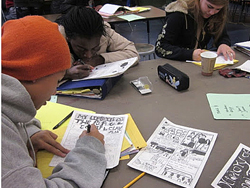From "My Odyssey" by Maria—about her journey with her brother from El Salvador to Oakland, and the coyotes that helped them
(We Are Oakland International, Copyright 2012 by Oakland International High School and Thi Bui, 112 pages)
In today's contentious immigration debates, it can be hard to remember that we are a nation whose offical seal carries the Latin phrase, E pluribus unum, "Out of many, one." At Oakland International High School , a public high school in Oakland for immigrant students, new students arrive each week. For many, OIHS is their first school in the United States. Its 300students come from 31 countries and speak 29 languages other than English. Each of these students has a story. Not all of them have a way of communicating it. 
For four years, OIHS art teacher Thi Bui has been urging her 9th and 10th grade students to tell their immigration story in the form of a comic. Recently, our WKCD mail included a hand-addressed envelope from students at OIHS, with a copy of the newly published We Are Oakland International—an astounding compilation of comics from Thi Bui's students. Each of the 23 comics—stories of loss and hope—answers the question, "Who am I?" and, collectively, the question "Who are we?" Together, they provide an extraordinary insight into the motives, challenges and dreams of our newest immigrants as they become part of the complex fabric of America.
Here we share art teacher Thi Bui's introduction to We Are Oakland International, a handful of the students' comics, and the audio of an interview with Bui and Maria, the student who describes her harrowing journey from El Salvador to Oakland in the comic, "My Odyssey."
Introduction by Thi Bui, Art Teacher, Oakland International High School
Excerpts (high resolution PDFs)
"A Big New Life" by Bao (Vietnam; 15 MB)
"For My Father" by Amar (Yemen; 7 MB)
"History of Nepal & Bhutan" by Jharna (9 MB)
"My Odyssey" by Maria (El Salvador; 8.3 MB)
"This Is My Immigration Story" by Tee Reh (Burma; 8 MB)
See online"flip book" of excerpts
Imagine you are 14 years old. Hormonal changes, pimples, self consciousness—the works. Now imagine that all that is the easy part of being you. For you are an immigrant; you have left your home and friends, you don’t know anybody at school, your family is split between two countries, you don’t know your way around your new city, and you don’t speak English.
When I began teaching at Oakland International High School, I had lofty ideas about the world events and issues I would be able to discuss with such an international mix of students. I too am an immigrant; I left Vietnam as a refugee when I was a child. But what I quickly realized stood between us was a language gap wider than any ocean. My pseudo-command of three other languages didn’t even begin to cover the multitude of languages that my students spoke.
The comics project began as a way for me to better understand my students. I found that if I taught everyone a new language, governed by a few simple conventions like panels and speech balloons, then we would have a common way of communicating that allowed students to surprise me. Over the years, as I learned to ask them better questions, my students have surprised, informed, inspired, and moved me to tears with their stories.
And these stories are just the tip of the iceberg. This year, an 11th grader named Bao rewrote the immigration story he did for me as a 10th grader. The original story, shown on these two pages, is undoubtedly beautiful but maybe just a little generic. Bao told me that the first time around, he was shy about sharing with other people the personal details of who he was.
The second time, he said, he opened his mind a little more. He had more experience, and he reflected more deeply about his characterization. Bao’s second version is on the pages that follow. It’s a fantastic story about childhood, adolescence, and nostalgia that reminds me of Rob Reiner’s film Stand By Me or François Truffaut’s The 400 Blows. Here is a young man who is becoming a storyteller; he is learning by figuring out what his own story really is.
So when you read these stories, remember that they are the first attempt by a person still forming his or her identity in an environment and language that is not native. Look deeper to imagine what more surely lies beneath. Look forward to picture the future of these teenagers who have already experienced so much. Recognize in them their great potential.



